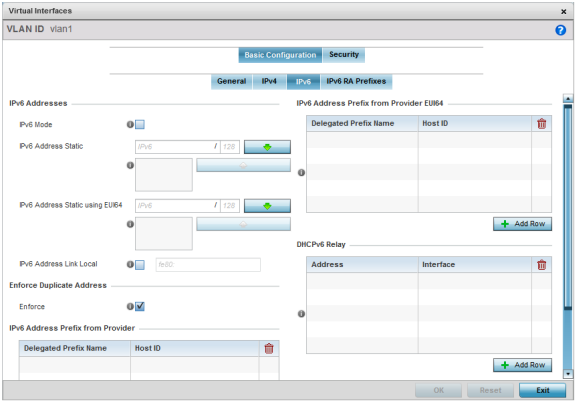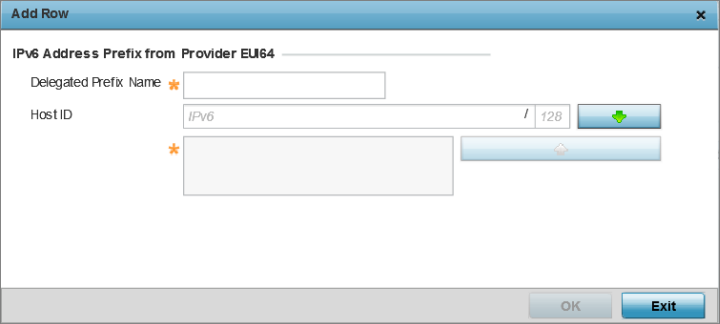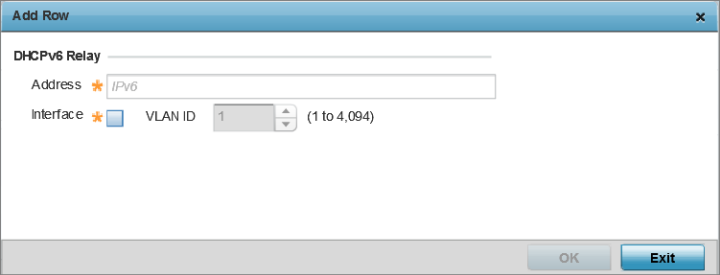OSPF IPv6 Settings
About this task
IPv6 is the latest revision of the Internet Protocol designed to replace IPv4. IPV6 provides enhanced identification and location information for computers on networks routing traffic across the Internet. IPv6 addresses are composed of eight groups of four hexadecimal digits separated by colons. IPv6 hosts can configure themselves automatically when connected to an IPv6 network using the neighbor discovery protocol via ICMPv6 router discovery messages. When first connected to a network, a host sends a link-local router solicitation multicast request for its configuration parameters; routers respond to such a request with a router advertisement packet that contains Internet layer configuration parameters.
To set the VLAN IPv6 settings:
Procedure
-
Select the IPv6 tab to set
IPv6 settings for this virtual interface.
The OSPF VLAN interface IPv6 configuration screen displays.
 OSPF - VLAN Interface IPv6 Configuration Screen
OSPF - VLAN Interface IPv6 Configuration Screen
-
Refer to the IPv6 Addresses
field to define how IP6 addresses are created and utilized.
IPv6 Mode
Select this option to enable IPv6 support on this virtual interface. IPv6 is disabled by default.
IPv6 Address Static
Define up to 15 global IPv6 IP addresses that can created statically. IPv6 addresses are represented as eight groups of four hexadecimal digits separated by colons.
IPv6 Address Static using EU164
Optionally set up to 15 global IPv6 IP addresses (in the EUI-64 format) that can created statically. The IPv6 EUI-64 format address is obtained through a 48-bit MAC address. The MAC is initially separated into two 24-bits, with one being an OUI (Organizationally Unique Identifier) and the other being client specific. A 16- bit 0xFFFE is then inserted between the two 24-bits for the 64-bit EUI address. IEEE has chosen FFFE as a reserved value which can only appear in EUI-64 generated from the an EUI-48 MAC address.
IPv6 Address Link Local
Provide the IPv6 local link address. IPv6 requires a link local address assigned to every interface the IPv6 protocol is enabled, even when one or more routable addresses are assigned.
- Enable the Enforce Duplicate Address option to enforce duplicate address protection when any wired port is connected and in a forwarding state. This option is enabled by default.
-
In the IPv6 Address Prefix from
Provider table, click + Add Row and
create IPv6 format prefix shortcuts as supplied by an ISP.
The IPv6 Address from Provider - Add Row screen displays.
 OSPF - IPv6 Add IPv6 Address Prefix from Provider Screen
OSPF - IPv6 Add IPv6 Address Prefix from Provider Screen
Delegated Prefix Name
Enter a 32 character maximum name for the IPv6 address prefix from provider.
Host ID
Define the subnet ID, host ID and prefix length.
-
Select OK to save the
IPv6 prefix from provider configuration changes.
Select Exit to close the screen without saving the updates.
-
In the IPv6 Address Prefix from
Provider EUI64 table, click + Add Row and
set an (abbreviated) IP address prefix in EUI64 format.
The IPv6 Address from Provider EU164 - Add Row screen displays.
 OSPF - IPv6 Add Address Prefixes from Provider EU164
OSPF - IPv6 Add Address Prefixes from Provider EU164
Delegated Prefix Name
Enter a 32 character maximum name for the IPv6 prefix from provider in EUI format. Using EUI64, a host can automatically assign itself a unique 64-bit IPv6 interface identifier without manual configuration or DHCP.
Host ID
Define the subnet ID and prefix length.
-
Select OK to save the
IPv6 prefix from provider in EUI64 format changes.
Select Exit to close the screen without saving the updates.
-
Refer to the DHCPv6 Relay table
to set the address and interface of the DHCPv6 relay.
The DHCPv6 relay enhances an extended DHCP relay agent by providing support in IPv6. DHCP relays exchange messages between a DHCPv6 server and client. A client and relay agent exist on the same link. When A DHCP request is received from the client, the relay agent creates a relay forward message and sends it to a specified server address. If no addresses are specified, the relay agent forwards the message to all DHCP server relay multicast addresses. The server creates a relay reply and sends it back to the relay agent. The relay agent then sends back the response to the client.
-
Select + Add Row to
launch a sub screen wherein a new DHCPv6 relay address and interface VLAN ID can
be set.
 OPSF - VLAN Interface DHCPv6 Relay Configuration Screen
OPSF - VLAN Interface DHCPv6 Relay Configuration Screen
Address
Enter an address for the DHCPv6 relay. These DHCPv6 relay receive messages from DHCPv6 clients and forward them to DHCPv6 servers. The DHCPv6 server sends responses back to the relay, and the relay then sends these responses to the client on the local network.
Interface
Select this option to enable a spinner control to define a VLAN ID from 1 - 4,094 used as the virtual interface for the DHCPv6 relay. The interface designation is only required for link local and multicast addresses. A local link address is a locally derived address designed for addressing on a single link for automatic address configuration, neighbor discovery or when no routing resources are available.
-
Click OK to save the
DHCPv6 relay configuration changes.
Click Exit to close the screen without saving the updates.


